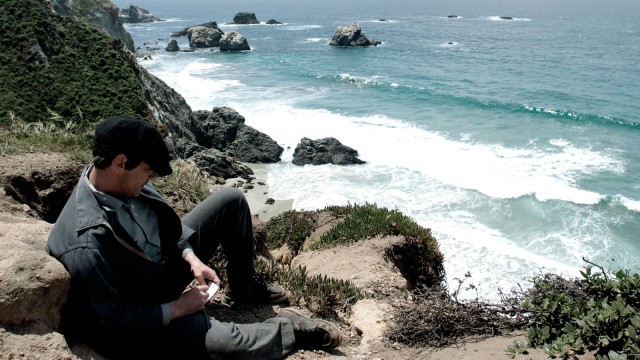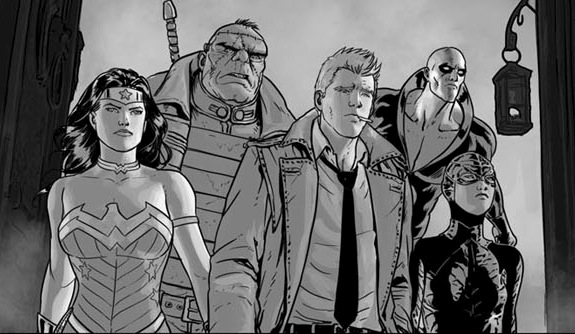 A Day in the Country
A Day in the Country
Written and directed by Jean Renoir
France, 1936
Jean Renoir’s A Day in the Country comes at a curious point in the director’s career. In 1936, he had several exceptional silent films to his credit, as well as such classics of early French sound cinema as La Chienne (1931), Boudu Saved from Drowning (1932), and The Crime of Monsieur Lange (1936), among others. But he had still not yet achieved his singular place on world cinema’s pre-war stage. That he would do just a year later, with La Grande Illusion (1937). As noted on the new Criterion Blu-ray, A Day in the Country was “conceived as a short feature…[and] nearly finished production in 1936 when Renoir was called away for The Lower Depths. Shooting was abandoned then, but the film was completed with the existing footage by Renoir’s team and released in its current form in 1946, after the director had already moved on to Hollywood.” Still, despite its unorthodox production and release, this little gem—little only because of its 41-minute runtime—is something special.
Based on a short story by Guy de Maupassant, the plot of A Day in the Country is admittedly slight. All aboard a borrowed milk cart, a Parisian hardware store owner and his family travel to the country, seeking rest and relaxation, seeking, as an opening title card states, to “commune with nature.” While there, little dramas unfold as they lazily lounge, play, and mingle with the residents and workers of a quaint provincial inn. The most prominent aspect of the narrative is the fleeting love that blooms between daughter Henriette Dufour (the beautiful Sylvia Bataille), and one of the young men employed at the inn, Henri (Georges D’Arnoux).
 Henriette’s presence sends Henri reeling, and he and his associate in work and romantic conquest, Rodolphe (Jacques B. Brunius), lustily leer at the girl as she elegantly and captivatingly swings. The audience too is enamored—this image of Bataille swinging is one of the most glorious in cinema history. For his part, Rodolphe sets his sights on the voluptuous and giddy mother, played by Jane Marken. Henriette is initially averse to Henri’s amorous advances, but Madame Dufour seems excitedly complicit, or perhaps just naive. It’s innocent enough in any case, and besides, the boisterous Monsieur Dufour (André Gabriello) is busy with his assistant, Anatole (Paul Temps), spouting off his words of wisdom, mostly about fishing. The analogy between these two and their sport and Rodolphe and Henri and theirs is a pointed one, with echoes of bait, tactic, and the ultimate attainment of their objects of desire.
Henriette’s presence sends Henri reeling, and he and his associate in work and romantic conquest, Rodolphe (Jacques B. Brunius), lustily leer at the girl as she elegantly and captivatingly swings. The audience too is enamored—this image of Bataille swinging is one of the most glorious in cinema history. For his part, Rodolphe sets his sights on the voluptuous and giddy mother, played by Jane Marken. Henriette is initially averse to Henri’s amorous advances, but Madame Dufour seems excitedly complicit, or perhaps just naive. It’s innocent enough in any case, and besides, the boisterous Monsieur Dufour (André Gabriello) is busy with his assistant, Anatole (Paul Temps), spouting off his words of wisdom, mostly about fishing. The analogy between these two and their sport and Rodolphe and Henri and theirs is a pointed one, with echoes of bait, tactic, and the ultimate attainment of their objects of desire.
A storm interrupts the pleasant summer weather, and it metaphorically signals an end to the romantic idyll. It was also noted in the opening title card that Anatole would soon be Monsieur Dufour’s son-in-law, and so it is. In the epilogue, we see that indeed Henriette has married the assistant and the two have returned to the country setting. There she again meets Henri and it becomes tragically clear that there was genuinely something meaningful in their one and only afternoon together. This heartrending witness to a romance that could have been were it not for the almost predestined marriage between Anatole and Henriette, is powerful, and as Renoir noted, “The theme is so important that it could very well have been a full-length film. A tale of disappointed love, followed by a ruined life could furnish matter for a long novel.”
 Throughout the film, contributing to a sense that whatever transpires during this excursion is not meant to be, or at least not meant to last, is the constant discussion of the country and its foreignness, in general and compared to the urban Paris. That alone seems to be a sort of barrier for the transpiring romance, as if distance from the city, or a difference in surroundings, automatically hinders a relationship. There is also talk of nature and her secrets, of the insects and their own potential love lives; Henriette speaks of feeling funny in nature, having a “tenderness,” a “vague sort of yearning.” This setting may as well be another planet for the city-dwellers.
Throughout the film, contributing to a sense that whatever transpires during this excursion is not meant to be, or at least not meant to last, is the constant discussion of the country and its foreignness, in general and compared to the urban Paris. That alone seems to be a sort of barrier for the transpiring romance, as if distance from the city, or a difference in surroundings, automatically hinders a relationship. There is also talk of nature and her secrets, of the insects and their own potential love lives; Henriette speaks of feeling funny in nature, having a “tenderness,” a “vague sort of yearning.” This setting may as well be another planet for the city-dwellers.
On the one hand, there are the obvious physical contrasts between the city and the country, with the trees, rivers, and open air, and the city, where, according to the characters, there isn’t enough oxygen. On the other hand, the contrast illustrates the romantic view with which the country is observed, by the characters and by Renoir. To the Dufour family, there is something ethereal about the dirt, the cherries, and the foliage. Similarly, Renoir lovingly shoots the water, the plants, the earth. Like the earliest Lumière films, there is an intrinsic cinematic fascination with the mere depiction of nature’s movements and details. This imagery is all the more pronounced thanks to the quality of this Blu-ray transfer.
There can be little doubt that Renoir’s treatment of nature is also under the influence of his father. In an interview on the Criterion disc, Christopher Faulkner goes into great detail about the aesthetic similarities between the art of Renoir the father and Renoir the son, and some rather revealing examples of Pierre-Auguste’s work are shown in convincing comparison. Even the Forest of Fontainebleau setting for A Day in the Country was likewise a favored backdrop for Impressionist painters. And as Gilberto Perez notes in his essay, “The film version of Maupassant’s story made by Renoir … conducts something of a dialogue between the painter and the writer.”
 The connection to his father notwithstanding, Renoir made A Day in the Country something of a family affair in other respects as well. He himself appears alongside his lover and partner, Marguerite Renoir, who also edited the film in Renoir’s absence, and credited elsewhere are nephew, Claude Renoir, as cinematographer, and son, Alain, as the young boy fishing at the start of the movie. Not related by blood but by cinema, assistants on the film included Jacques Becker (who directed potions of the film while Renoir was away), Henri Cartier-Bresson, and Luchino Visconti. Nearly everyone above is seen in Un tournage à la campagne, a nearly 90-minute compilation of outtakes from the film. This is a fascinating historical document, revealing rare glimpses of Renoir’s working methods and the candid behavior of those involved (one also sees young Alain holding the clapperboard).
The connection to his father notwithstanding, Renoir made A Day in the Country something of a family affair in other respects as well. He himself appears alongside his lover and partner, Marguerite Renoir, who also edited the film in Renoir’s absence, and credited elsewhere are nephew, Claude Renoir, as cinematographer, and son, Alain, as the young boy fishing at the start of the movie. Not related by blood but by cinema, assistants on the film included Jacques Becker (who directed potions of the film while Renoir was away), Henri Cartier-Bresson, and Luchino Visconti. Nearly everyone above is seen in Un tournage à la campagne, a nearly 90-minute compilation of outtakes from the film. This is a fascinating historical document, revealing rare glimpses of Renoir’s working methods and the candid behavior of those involved (one also sees young Alain holding the clapperboard).
In his introduction to the film, Renoir says he wanted to make “a short film that was as well-made as a feature film.” While that in itself isn’t overly exceptional, especially given that, among other examples, Renoir’s fellow countryman Jean Vigo had directed the wonderful Zero for Conduct (41 minutes) just three years prior, he does also allude to having had in mind potential omnibus programs made up of several such high quality shorts. That farsighted notion did reach a point of popularity and uneven success in the 1950s and ’60s.
Renoir also speaks about the benefits of using preexisting material, like the Guy de Maupassant story, as a place from which to launch a film. In favor of plagiarism, Renoir views source material as a “framework to embellishments.” By using a story from another, Renoir contends that the filmmaker is free from unimportant details—details, he says, like the story. To follow his line of thinking then, if A Day in the Country is what such cinematic freedom looks like, long live plagiarism.






